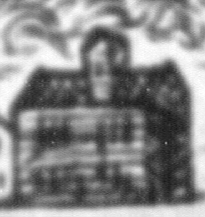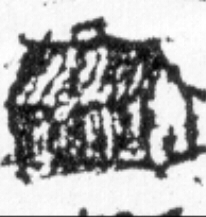


When a friend told us that a token had been issued “at the Glass House in Calne” (Wiltshire) in 1669, this was our first indication of the glass house's existence. It seems also to have been a surprise to both local history and glass history experts. A site at Buckholt, north of Salisbury on the Hampshire / Wiltshire border, has been know since the nineteenth century, but that was much earlier, having closed fifty years before this token was issued. There is always a risk of misunderstanding a single piece of information such as this. What were the chances that there really was a glass house? The first piece of supporting evidence came from Peter Saunders of Salisbury Museum, who managed to track down an illustration of the token in W.Boyne’s Tokens of the Seventeenth Century. This showed a depiction of the glass house and the initials A.I(J).S. The figures below, show that this depiction matches well those of glass houses from maps of other locations. There is little chance that the engraver copied either of these, since they are respectively five and eleven years later. It is also interesting that the token shows a central arch; a feature not shared with the other illustrations, but one that has been found on surviving remains of late seventeenth century glass houses. So it looks like there was actually a glass house.
|
|
|
|
|
|
Why would glassmakers have chosen Calne? The first clue is in the geology of the area. Local people knew in the mid-seventeenth century that there were materials for making glass available in the area. We know this because they told the well known author John Aubry. He recorded this when writing about Bowdon, to the west of Calne, in his Topographical Collections of 1659-70; stating on page 94:
‘Mem. The sand on the hills hereabout is very fitt for a glasse work, and Compton (Basset) stone for a furnace.’
‘Mem.The deep lane from Bowdon to Ray-bridge is very full of nitre, as a warm day will evidence;... ‘
Compton Basset is just to the north-east of Calne and Nitre (saltpetre - potassium nitrate) was a key ingredient of high-quality glass. On page 41 he gives more detail about the stone:
‘In this parish is a quarry of soft white stone, betwixt chalke and freestone, which they use much for ovens, it endures the fire rarely well, and I doubt not but it would be good for a glass furnace, or iron forge or chymists.’
He amplifies his reference to sand in his later Natural History of Wiltshire, but, as stated in the preface, this book was mainly based on notes made whilst living in the area. On page 36 he writes:
‘The first ascent from Chippenham, sc. above the Derry hill is sandy: e.g. Bowdon-parke, Spy-parke, Sandy-lane, of which I believe good glasse might be made; but it a little too far from a navigable river. They are ye biggest graines of sand that ever I saw, and very transparent: some where thereabout is sand quite white.’
All the places named are to the west of Calne and the references are clearly to good quality sand from the lower greensand geological formation. Calne marks almost the furthest westerly extent of this formation in England. The strata is also accessible just south of Calne and to the east of the town. Possibly one of these sites was the ‘somewhere thereabout’ to which he referred. What he did not mention was that at the latter two sites the sand is overlaid on Kimmeridge clay. This clay was almost certainly suitable for making glass-melting pots. Christopher Merret writing in 1662 refers to the use of clay from Purbeck for this purpose and this may well have come from the vicinity of Kimmeridge. Saltpetre making was not new in the area when Aubrey wrote, since there is mention of moving saltpetre tubs in the 1654 entry of the Calne Guild Stewards' Book.
Aubrey was not a scientist, but he knew influential people who were. Thus his books probably record accurately what he had been told, but he does not necessarily place this in the most appropriate context. In the same book he mentions three new glass houses being built in the Gloucester / Worcester area. When this was written is unclear, possibly before April 1670 when he left Wiltshire. He talks about these glass houses in the context of window glass, but they were much more likely to have been making bottles. It seems unlikely that the glasshouse was working at Calne when he was collecting the material for his books, since he would almost certainly have mentioned this fact. Equally, he only mentions glass-making materials in the context of the Calne area, suggesting that preparatory work to establish the feasibility of running a glasshouse in the area had already started.
Aubrey’s mention of the distance from a navigable river reflects the difficulty of transporting materials at that period. What is interesting is that he does not address fuel for glass making. Then, a working glass house might consume up to four hundred and fifty tons of coal a year or about twice this weight of wood if it was wood-fired. Access to good sand, clay and stone would have been valueless unless there was also good access to fuel. Since there are no known local coal deposits, this suggests that the glass house was probably burning wood. If this could be positively established it would be an important finding. James I, in a proclamation of 1614, prohibited the use of wood fuel for glass making, in order to safeguard the availability of timber for the strategic purpose of shipbuilding. This concern was probably justified. Sir Robert Mansel, giving written evidence to Parliament in 1624, stated:
‘..and that Buckall within sixe miles of Salisbury, being a Wood of great content, and seated in a scarce Country was wholy consumed by Glasses-workes, to the great damage of the City and Country about, beeing now driven to fetch their wood ten miles from their habitations..’
This may represent rather an overstatement, since Sir Robert was a biased observer. Also, glass may have been made at Buckholt for as long as forty years. There is evidence that at least one London glass house was burning wood in the 1670s and possible indications that two or three more were also using this fuel. It had been assumed that few glass houses re-introduced wood firing, but information from this research may trigger a major reassessment of this assumption. If the Calne glass house was burning wood, then it is unlikely to have worked for a long period without giving rise to vocal public complaint about the loss of local timber. It is possible that the glass house operation corresponded with a period when a major landowner was clearing his estate in order to improve its agricultural yield.
A glasshouse would also probably have needed access to considerable quantities of water, since this was used in purifying the ingredients. Reasonable road access was probably also required, even if it was situated relatively close to a source of fuel, since much of it would probably need to be moved by road. There was also a need for itinerant glass sellers and wagons to have access to carry-away the finished products. There is no evidence of a glass house on the map of the London-Bristol road produced by John Ogilby in 1675.
Why 1669? The date of the token is quite significant. There was considerable interest in improving the English glass-making industry at that time. This had been partly fuelled by Christopher Merret’s translation of a text book on glass making from Italian to English in 1662; the result of a commission from the new Royal Society. Almost certainly Aubrey and Merret would have known each other through the Royal Society. There was an increasing demand for glass, driven by changes in society after the restoration, particularly the growing importance of ‘fashion’. Demand would also have been driven by the need to replace glass destroyed during the fire of London. The latter had also reduced supply through its destruction of at least one major glass house. Finally there was a significant demand for glass to support the new colonies overseas, particularly through the growing port of Bristol, which did not yet have its own glass houses. So the late 1660’s saw a shortage of glass in England. This was partially answered by large-scale importation from Venice until about 1673. It would probably have taken a couple of years to get a new glass house established, particularly to set-up the large store of dry timber that wood-firing would need. One would not expect a new glass house to be working in response to the situation created by the fire of London before about 1668. If this supposition is correct, Calne was probably the first of several places aiming to cash-in on the glass shortage. In fact there may have been as many as ten new glass houses opened in the early 1670s. Many of these were large-scale coal-burning houses, well situated for waterborne transport and with ready access to urban markets. These must soon have presented strong competition for a glass house in Calne, both in terms of the market and for the skilled glassmakers on which they all depended. Some of the new glasshouses also introduced new glassmaking technologies, enabling them to produce a higher-value product. It would be surprising if the glass house survived much beyond the mid 1670s for these reasons.
Who was AJS? The initials on the token are likely to refer to a person’s name, with the central ‘I’ being interpreted as a modern ‘J’. Where three initials occur like this on a token it usually refers to the husband's and wife's initials. Glass houses were 'high tech' places in the seventeenth century. Pepys, Evelyn and Hooke all record visiting glass houses in their diaries. In France, skilled glassmakers were automatically considered part of the nobility. Thus the person involved was likely to have had a high standing in the local community. However, the initials are more likely to be of the person who financed the setting-up of the works, than to the senior craftsman (gaffer) working there. Sometimes glassmakers financed their own works, but this was not common. The most likely candidate mentioned in the Calne Guild Book was Anthony Smith. He is mentioned several times in 1669, but not in any other year. He married Jane Smith in Calne in 1659 and is recorded as being buried in near-by Blacklands in 1675. Another possibility is that it was a Mr Stephens who hired a horse to ride to Henley in 1672/3. A new glass house was being established at Henley at that time.
What kind of glass did it make? Seventeenth century glass houses apparently specialised in producing window, bottle, mirror/plate or vessel glass. Of these, only vessel glass is associated with wood firing and only the last two are known to have used saltpetre as an ingredient. The other types of glass used the cheaper ingredient potash. No mirror/plate glasshouse is known outside London. This suggests that vessel glass was the most likely product. A number of fragmentary drinking glass finds from west of England excavations (Exeter, Oxford & Wells) appear to date from the late 1660’s / early 1670’s and to be different from those in London and the east of England. It is possible that these may be, or may include products from Calne. The next nearest glass house known to be producing drinking glass then was at Stourbridge.